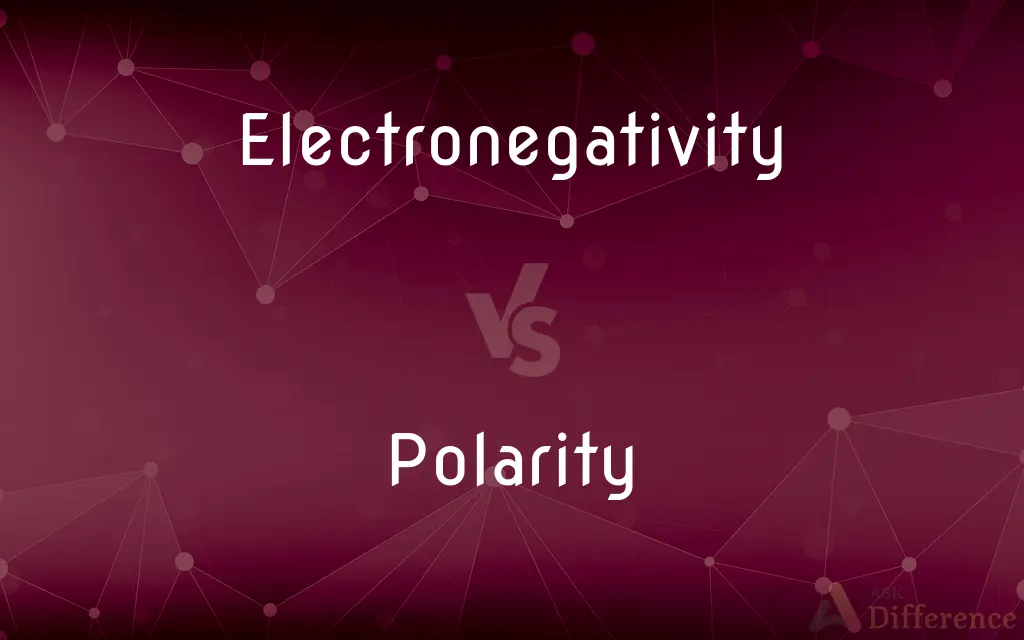Electronegativity vs. Polarity — What's the Difference?
By Maham Liaqat & Fiza Rafique — Updated on April 17, 2024
Electronegativity is a measure of an atom's ability to attract shared electrons, while polarity refers to the distribution of electrical charge over a molecule.

Difference Between Electronegativity and Polarity
Table of Contents
ADVERTISEMENT
Key Differences
Electronegativity describes how strongly an atom can attract electrons in a chemical bond. On the other hand, polarity indicates whether a molecule has a dipole moment, where charges are unevenly distributed across the molecule, leading to a partial positive and a partial negative side.
In the periodic table, electronegativity generally increases from left to right and decreases down a group. Conversely, polarity is not a property of atoms but of molecules and depends on both the difference in electronegativity between bonded atoms and the molecule's shape.
A high difference in electronegativity between two atoms in a bond often leads to a polar bond, meaning the electrons are shared unequally. Whereas, if the electronegativity difference is low, the bond is likely to be nonpolar, with a more equal sharing of electrons.
Electronegativity is a unitless measure typically calculated using scales such as the Pauling scale. In contrast, polarity in molecules can be quantified by the dipole moment, measured in Debye units, which reflects both the charge difference and the distance between the charges.
Elements like fluorine have the highest electronegativity and strongly attract electrons. Meanwhile, compounds such as water (H₂O) are highly polar due to the large electronegativity differences between hydrogen and oxygen and the angular shape of the molecule, which does not allow the polar bonds to cancel out.
ADVERTISEMENT
Comparison Chart
Definition
Ability of an atom to attract electrons
Distribution of electrical charge over a molecule
Measured By
Unitless (e.g., Pauling scale)
Dipole moment (Debye units)
Depends On
Atomic properties
Electronegativity difference and molecular geometry
Example of High
Fluorine (most electronegative element)
Water (highly polar molecule)
Resulting Property
Type of chemical bond (ionic, covalent)
Molecular behavior (solubility, reactivity)
Compare with Definitions
Electronegativity
A chemical property that describes an atom's tendency to attract a shared pair of electrons.
Fluorine has a high electronegativity, making it very effective at attracting electrons.
Polarity
A result of both molecular geometry and electronegativity differences.
Despite carbon dioxide having polar bonds, its linear geometry makes it a nonpolar molecule.
Electronegativity
Influences the polarity of molecules when differing significantly between bonded atoms.
The large electronegativity difference between hydrogen and oxygen leads to water's high polarity.
Polarity
Measured by the molecular dipole moment.
The dipole moment of water is high due to its angular shape and the difference in electronegativity between its atoms.
Electronegativity
Varies across the periodic table and is used to predict bond types.
Electronegativity differences between bonded atoms can indicate whether a bond will be ionic or covalent.
Polarity
Influences a molecule's physical properties, such as boiling point and solubility.
Polar molecules like alcohol have higher boiling points than their nonpolar counterparts.
Electronegativity
Fundamental in determining the chemical behavior of molecules.
Elements with high electronegativity tend to form acids when combined with hydrogen.
Polarity
A molecule's characteristic that includes a skewed distribution of electrons.
The polarity of water molecules makes them excellent solvents for ionic compounds.
Electronegativity
Measured on several scales, the most common being the Pauling scale.
On the Pauling scale, oxygen has an electronegativity of 3.44.
Polarity
Essential for understanding molecular interactions and reactions.
Polarity determines how molecules interact with each other in different phases or mixtures.
Electronegativity
Electronegativity, symbolized as χ, is the tendency for an atom of a given chemical element to attract shared electrons (or electron density) when forming a chemical bond. An atom's electronegativity is affected by both its atomic number and the distance at which its valence electrons reside from the charged nucleus.
Polarity
Intrinsic polar separation, alignment, or orientation, especially of a physical property
Magnetic polarity.
Ionic polarity.
Electronegativity
(chemistry) The tendency, or a measure of the ability, of an atom or molecule to attract electrons when forming bonds.
Polarity
An indicated polar extreme
An electric terminal with positive polarity.
Electronegativity
(chemistry) the tendency of an atom or radical to attract electrons in the formation of an ionic bond
Polarity
The possession or manifestation of two opposing attributes, tendencies, or principles
Political polarity.
Polarity
The separation, alignment or orientation of something into two opposed poles.
Polarity
Either of the two extremes of such attributes.
Polarity
(chemistry) The dipole-dipole intermolecular forces between the slightly positively-charged end of one molecule to the negative end of another or the same molecule. Wp
Polarity
(embryology) The division of an embryo into an animal pole and a vegetal pole within a blastula. Wp
Polarity
(microbiology) Spatial differences in shape, structure, and function within a cell. Wp
Polarity
(electricity) A measure of the electrical potential at the ends of a circuit. Wp
Polarity
(physics) The direction of a wave's amplitude or its being in phase or antiphase.
Polarity
(grammar) The grammatical category of the affirmative and the negative. Wp
Polarity
A duality that is an involution, i.e. has order two. Wp
Polarity
(mathematics) An indicator of the positivity or negativity of a literal. Wp
Polarity
(politics) Any of the various ways in which power is distributed within the international system. Wp
Polarity
(gender) The concept of dualism between masculine and feminine. Wp
Polarity
(physics) magnetic polarity
Polarity
(geometry) trilinear polarity
Polarity
That quality or condition of a body in virtue of which it exhibits opposite, or contrasted, properties or powers, in opposite, or contrasted, parts or directions; or a condition giving rise to a contrast of properties corresponding to a contrast of positions, as, for example, attraction and repulsion in the opposite parts of a magnet, the dissimilar phenomena corresponding to the different sides of a polarized ray of light, etc.
Polarity
A relation between two opposite attributes or tendencies;
He viewed it as a balanced polarity between good and evil
Polarity
Having an indicated pole (as the distinction between positive and negative electric charges);
He got the polarity of the battery reversed
Charges of opposite sign
Common Curiosities
Which factor contributes more to polarity: electronegativity difference or molecular geometry?
Both factors are crucial, but molecular geometry can override the effects of electronegativity differences, as seen in molecules like carbon dioxide.
What role does electronegativity play in organic chemistry?
In organic chemistry, electronegativity is key to understanding the behavior of molecules, such as the acidity of organic acids and the reactivity of different functional groups.
Is there a correlation between electronegativity and element reactivity?
Yes, generally, elements with higher electronegativity are less reactive as metals but more reactive as non-metals.
How does the polarity of a molecule influence its boiling point?
Polar molecules tend to have higher boiling points due to strong intermolecular forces, like hydrogen bonding, which require more energy to overcome.
What happens to molecular polarity when electronegativity difference is zero?
When the electronegativity difference is zero, the bond is completely nonpolar, as the electrons are shared equally between the atoms.
What are some common applications of understanding polarity in daily life?
Understanding polarity helps in mixing chemicals, selecting solvents, and in the pharmaceutical industry to design drugs that interact properly with the body.
How does polarity affect solubility?
Polarity affects solubility by determining which substances can dissolve in others; "like dissolves like," meaning polar substances tend to dissolve well in polar solvents, and nonpolar substances in nonpolar solvents.
What is a dipole moment, and how is it measured?
A dipole moment is a measure of the separation of positive and negative charges in a molecule; it is measured in Debye units and indicates the polarity of the molecule.
What is an example of a polar molecule with a simple structure?
Hydrochloric acid (HCl) is a simple polar molecule, resulting from the significant electronegativity difference between hydrogen and chlorine.
What are polar covalent bonds, and how do they form?
Polar covalent bonds form when there is a moderate difference in electronegativity between two atoms, leading to unequal sharing of electrons.
Can a molecule with identical atoms be polar?
No, a molecule with identical atoms, like O2 or N2, is always nonpolar because there is no electronegativity difference to create a dipole moment.
Can polarity affect the electrical properties of a material?
Yes, polarity can significantly affect a material's electrical properties, such as its conductivity and dielectric constant.
Why are ionic compounds generally more soluble in water than covalent compounds?
Ionic compounds are more soluble in water because the polar water molecules can more effectively separate and surround the charged ions than they can nonpolar molecules.
How does molecular polarity affect environmental behavior of chemicals?
Molecular polarity influences how chemicals distribute in the environment, such as their solubility in water versus oil, impacting everything from pollution dispersal to biological uptake.
How do nonpolar molecules interact with each other?
Nonpolar molecules interact through van der Waals forces, which are weaker than the interactions in polar molecules, leading to different physical properties.
Share Your Discovery

Previous Comparison
Language vs. Langauge
Next Comparison
Oneself vs. ThemselfAuthor Spotlight
Written by
Maham LiaqatCo-written by
Fiza RafiqueFiza Rafique is a skilled content writer at AskDifference.com, where she meticulously refines and enhances written pieces. Drawing from her vast editorial expertise, Fiza ensures clarity, accuracy, and precision in every article. Passionate about language, she continually seeks to elevate the quality of content for readers worldwide.














































